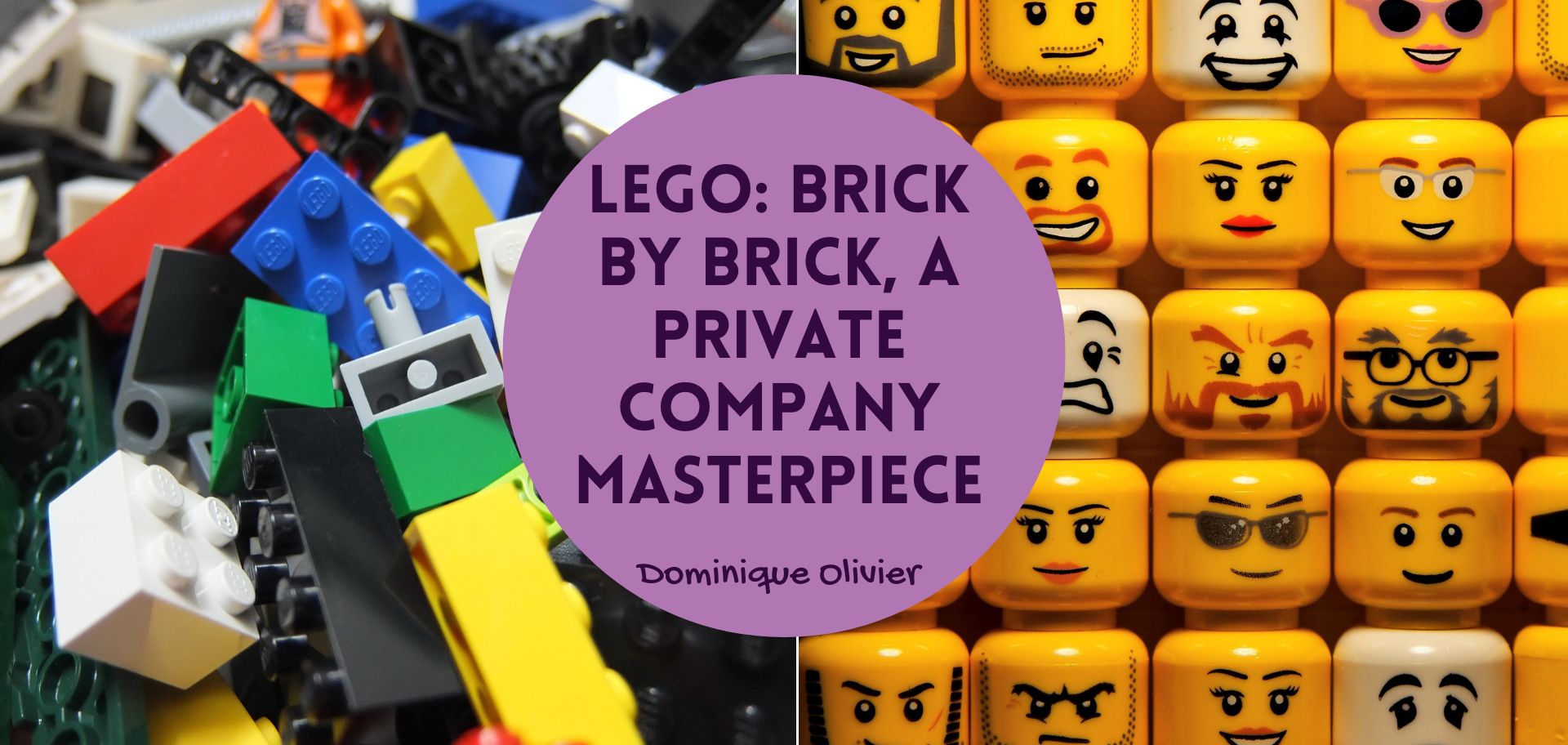Lego’s journey from a small Danish workshop to a global powerhouse is a tale of innovation, adaptability, and the enduring magic of play – not to mention succession planning and how family businesses can become legacies. But with playtime lasting almost a century already, can they keep putting new spins on their game before the players lose interest?
It all started during the Great Depression in 1932 when Ole Kirk Christiansen, a carpenter in Billund, Denmark, began making smaller versions of his full-size furniture pieces. Initially conceived as design aids, these miniature wooden furniture sets soon captured the imaginations of children, so Christiansen, being a smart businessman, went where the ducks were quacking and started marketing his creations as toys.
Despite the tough economic times, Christiansen’s commitment to quality craftsmanship set his products apart. His toys became increasingly popular, even in circumstances where consumers were so poor that they would barter home-grown vegetables for them. The name “Lego,” coined in 1934 from the Danish phrase “leg godt” meaning “play well,” perfectly encapsulated the company’s philosophy.
A material evolution
Christiansen’s early wooden toys were popular enough, but the post-World War II era brought new opportunities with the advent of plastic. Sensing the potential, Lego purchased an injection-moulding machine in 1947, becoming one of the first companies in Denmark to do so. This move was groundbreaking, allowing Lego to create the first plastic interlocking bricks in Europe in 1949, initially called “Automatic Binding Bricks.” Inspired by Kiddicraft’s Self-Locking Bricks, these early versions paved the way for the modern Lego brick we know today. Lego bricks, then manufactured from cellulose acetate, were developed in the spirit of traditional wooden blocks that could be stacked upon one another but could be “locked” together. They had several round “studs” on top and a hollow rectangular bottom. They would stick together, but not so tightly that they could not be pulled apart.
At first, plastic products didn’t catch on with customers, who preferred wooden or metal toys. Lego had to deal with a lot of returns due to poor sales. Then, in 1955, they launched the “Town Plan,” using plastic Lego building bricks as the system.
The bricks got a lukewarm reception and had some technical issues. Their “locking” ability was limited, and they weren’t very versatile. But in 1959, Lego improved the bricks by adding hollow tubes to the underside. This change made the bricks lock together better and be more versatile. The company patented the new design and several similar ones to fend off competition.
After a devastating warehouse fire struck the Lego Group in 1960, most of the business’ inventory of wooden toys was destroyed. Ole’s son, Godtfred Kirk Christiansen, made the decision then and there that the plastic line was strong enough to abandon the production of wooden toys. Despite the fact that this decision caused his brothers, Gerhardt and Karl Georg, to leave the company and start their own toy business, Godtfred stood firm by his vision and vowed to steer Lego’s plastic toy line into the future.
Keeping it in the family
Perhaps one of the most astonishing things about the Lego story is that it has remained a family-owned business for the entirety of its existence – and for most of that existence, it was family-run too. Godtfred, who formally took over the business after his father’s death in 1959, played a crucial role in expanding the company’s vision. He introduced the Lego System of Play, emphasising a cohesive system where every brick could connect, ensuring compatibility across sets. This approach fostered creativity and endless building possibilities.
Godtfred’s son, Kjeld Kirk Kristiansen, joined the managerial staff in 1972 after earning business degrees in Switzerland and Denmark. One of Kjeld’s first achievements with the company was the foundation of manufacturing facilities, as well as the research and development department that would be crucial for keeping the company’s manufacturing methods up to date.
The family’s leadership ensured that Lego’s core values of quality and creativity remained intact even as the company grew. Under Godtfred’s guidance, Lego introduced themed sets and the beloved minifigures, which soon became an integral part of the Lego experience. Kjeld’s leadership oversaw the introduction of innovative specialty ranges such as Technic, Duplo, Light & Sound and Bionicle.
For 72 years, the descendants of Ole Kirk Christiansen steered the Lego brand from one innovation to the next – but their legacy of success could not be maintained. In the face of near bankruptcy in 2004, Kjeld Kirk Kristiansen, Ole’s grandson, stepped down as CEO, marking the end of direct family leadership. The family would remain involved through the Lego Foundation and the board of directors, but they would no longer head up operations. Jørgen Vig Knudstorp, the new CEO, managed to lead the company through a remarkable turnaround while staying true to the company’s heritage.
Crash and revive
Despite its years of successes, Lego faced significant challenges in the late 1990s and early 2000s. The rise of video games and electronic toys threatened traditional play, and internal missteps led to overexpansion and a diluted focus on core products. By 2003, Lego was teetering on the brink of financial collapse, reporting its first losses in decades.
In response, Lego underwent a major restructuring. This included streamlining operations, cutting costs, and refocusing on the core product – the Lego brick. The company scaled back on non-core ventures, sold off Legoland parks, and renewed its commitment to quality and innovation.
By 2007, Lego had downsized from a global workforce of 9,100 in 1998 to 4,200, mainly due to outsourcing. In the US, Lego sales jumped 32% thanks to Star Wars and Indiana Jones-themed sets, while global sales rose by 18% in 2008. In 2009, Mads Nipper, Lego executive vice-president of marketing, noted that licensed themes played a bigger role in the American market compared to overseas. About 60 percent of Lego’s American sales were linked to licences, double the percentage from 2004. Nipper mentioned that by 2009, Lego had become “definitely more commercially oriented.”
Beyond the brick
Lego’s resilience and ability to innovate were exemplified by its ventures beyond traditional toys. The 2014 release of “The Lego Movie” in partnership with Warner Bros was a masterstroke, blending storytelling with brand marketing. The film was a global success, grossing over $468 million and proving that Lego’s appeal transcended generations. More than just a movie, this was a celebration of creativity, imagination, and the joy of building.
This success spurred sequels, spin-offs and a renewed interest in Lego products. Lego also continued to capitalise on its intellectual property through partnerships with popular franchises like Star Wars, Harry Potter, and Marvel. These collaborations brought new fans to the brand and allowed for the creation of unique, themed sets that appealed to both children and adult collectors.
How do they keep coming up with new sets after almost a century? Well, that’s where things get really interesting. Lego Ideas is a platform where fans can submit their own designs for potential production, further engaging the community while making sure that the designers behind Lego don’t find themselves stuck in an echochamber. This initiative harnesses the creativity of Lego enthusiasts worldwide, turning fan ideas into official sets and fostering a sense of community and shared creativity.
Play on
Lego’s journey from a small Danish workshop to a global icon is a testament to its ability to innovate and adapt while staying true to its core values. The company’s commitment to quality, creativity, and the joy of play has made it a beloved brand across generations. Despite facing significant challenges, the brand has shown remarkable resilience and an ability to reinvent itself.
The story of Lego is not just about the bricks, but about the endless possibilities they represent – a legacy that will undoubtedly continue to build a better future, one brick at a time.
Ghost’s note: don’t forget Lego for adults, either! I bought the Lego Peugeot Le Mans set to remember the recent trip by. This brand is an absolute powerhouse across all ages.
About the author: Dominique Olivier

Dominique Olivier is the founder of human.writer, where she uses her love of storytelling and ideation to help brands solve problems.
She is a weekly columnist in Ghost Mail and collaborates with The Finance Ghost on Ghost Mail Weekender, a Sunday publication designed to help you be more interesting.
Dominique can be reached on LinkedIn here.





Very interesting indeed, had no idea they originated in Denmark, played with these myself, along with Mechano sets in my youth.. great story.
Indeed, Lego has a very nice backstory. I grew up with maybe 10 Lego sets in the house but my young kids have now far surpassed me 😅
Although the Lego company is privately held, you could always invest in Lego sets… I was looking at pictures of Lego Star Wars minifigs on brickset and bricklink for my son’s upcoming birthday cake, and stumbled upon the unicorn that is Cloud City (set #10123).
This quirky set retailed in 2003 for $100 and now goes for around $7700 new in box. That’s a Lego set that costs more than a car! The annualised return of 23% over 21 years is not too shabby. In fact, it’s better than Google over the same period. 😁
If you are not sure how to pick such winners, you also have the opportunity to arbitrage Lego sets across jurisdictions based on supply and demand (although a bit harder in recent years).
Here’s a story to explain why this company is so good:
I recently built a toy fox with my 7year old , only to have a specific piece break when the incomplete piece fell to the floor. After much drama , I contacted Lego on their website, entered the broken piece number and 10 days later got a free delivery couriered from Denmark – with a letter thanking me for my support and the missing piece! Now that’s customer service !!